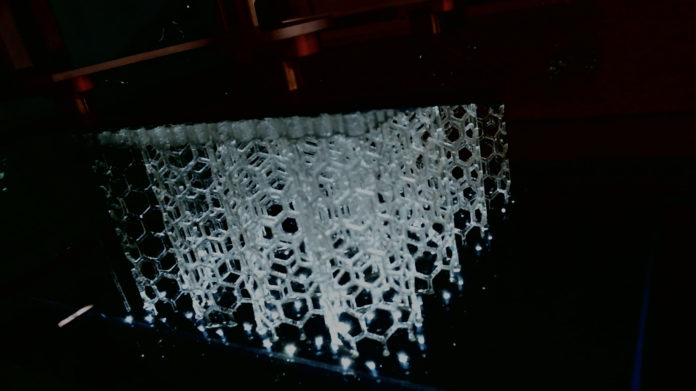HARP for high-area rapid printing, is a new technology that can manufacture products on demand. According to researchers from Northwestern University the futuristic 3D printer is so big and so fast it can print an object the size of an adult human in just a few hours.
Indeed, the prototype HARP technology is 13-feet tall with a 2.5 square-foot print bed and can print about half a yard in an hour. In other terms, it can print single, large parts or many different small parts at once.
“3D printing is conceptually powerful but has been limited practically,” said Northwestern’s Chad A. Mirkin, who led the product’s development. “If we could print fast without limitations on materials and size, we could revolutionize manufacturing. HARP is poised to do that.”
A patent-pending version of SLA Technology
HARP uses a new, patent-pending version of stereolithography, a type of 3D printing that converts liquid plastic into solid objects. HARP prints vertically and uses projected ultraviolet light to cure the liquid resins into hardened plastic. This process can print pieces that are hard, elastic or even ceramic. These continually printed parts are mechanically robust as opposed to the laminated structures common to other 3D-printing technologies. They can be used as parts for cars, airplanes, dentistry, orthotics, fashion and much more.
A major limiting factor for current 3D printers is heat. Every resin-based 3D printer generates a lot of heat when running at fast speeds — sometimes exceeding 180 degrees Celsius. Not only does this lead to dangerously hot surface temperatures, it also can cause printed parts to crack and deform. The faster it is, the more heat the printer generates. And if it’s big and fast, the heat is incredibly intense.
This problem has convinced most 3D printing companies to remain small. “When these printers run at high speeds, a great deal of heat is generated from the polymerization of the resin,” Walker said. “They have no way to dissipate it.”
‘Liquid Teflon’
The Northwestern technology bypasses this problem with a nonstick liquid that behaves like liquid Teflon. HARP projects light through a window to solidify resin on top of a vertically moving plate. The liquid Teflon flows over the window to remove heat and then circulates it through a cooling unit.
“Our technology generates heat just like the others,” Mirkin said. “But we have an interface that removes the heat.”
“The interface is also nonstick, which keeps the resin from adhering to the printer itself,” Hedrick added. “This increases the printer’s speed by a hundredfold because the parts do not have to be repeatedly cleaved from the bottom of the print-vat.”
The whole research has been posted in the Journal Science.
You can now post free of charge job opportunities in the AM Industry on 3D ADEPT Media. For further information about 3D Printing, follow us on our social networks and subscribe to our newsletter : Facebook, Twitter, LinkedIn & Instagram !Would you like to be featured in the next issue of our digital magazine? Send us an email at contact@3dadept.com






